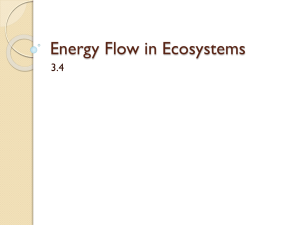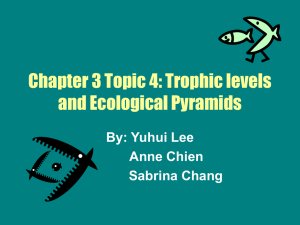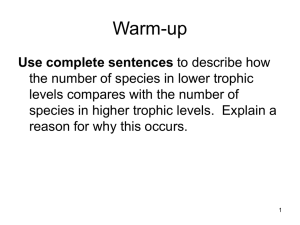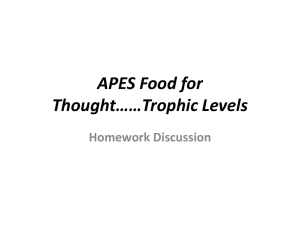Trophic Pyramid
advertisement
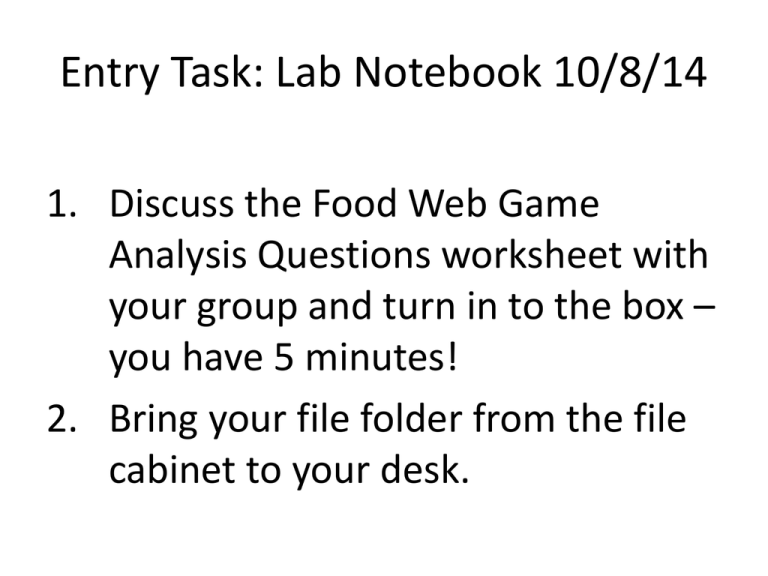
Entry Task: Lab Notebook 10/8/14 1. Discuss the Food Web Game Analysis Questions worksheet with your group and turn in to the box – you have 5 minutes! 2. Bring your file folder from the file cabinet to your desk. Trophic Pyramid Learning Target: I can determine which trophic level each organism occupies and explain why. Great Salt Lake Food Web • Working with your table group… – Write the name of each GSL organism on a notecard (hint: Use your initial model) – Organize the organisms into a food web – Arrange the organisms by trophic levels Trophic Levels • Trophic levels are what position you hold in the food web. • The levels are known as: • • • • • Producer Primary consumer Secondary consumer Tertiary consumers Decomposer. Trophic Levels – Producer: don’t eat other things. They make their own energy by using sunlight. – Primary consumer: when they eat producers. TURN & TALK: What – Secondary consumer: when trophic level do they eat primary consumers. decomposers – Tertiary consumers: when they occupy? eat secondary consumers. – Decomposer: break down and eat any dead organism. Trophic Levels – Producer: don’t eat other things. They make their own energy by using sunlight. – Primary consumer: 1°C =when they eat producers. – Secondary consumer: 2°C = when they eat primary consumers. – Tertiary consumers: 3°C = when they eat secondary consumers. – Decomposer: break down and eat any dead organism. Trophic Pyramids • To organize a food web we make trophic pyramids. • All producers go on the bottom, primary consumers next, secondary consumers third and tertiary consumers on top of the pyramid. Energy in Trophic Pyramids • Energy moves up the trophic levels TURN & TALK: If you So eatwhich a burger, are you because thedirection would energy move in giving the burger upper levels are a energy trophicor pyramid? Up is the burger eating the lower or down? giving you energy? levels and using them for energy. Energy in Trophic Pyramids • Energy gets lost at each level due to: • • • Energy getting transformed into other energy inside the consumer. Not all of the food is eaten up. Waste (feces, urine, respiration) Biomass in Trophic Pyramids • Because energy is always moving up the trophic levels there has to be more, in numbers, of the lower levels. • Due to space available the lower levels have to be smaller in size and the upper levels get bigger and bigger. Biodiversity of the Lake • Cyanobacteria is a bacteria. It doesn’t eat because it makes it’s own energy from the sun. • Diatoms are algae. They also make their own energy from the sun. • Halobacteria are Archaea. They also make their own energy from the sun. • • • • • • • Biodiversity of the Lake Many organisms live in or near the lake. Northern Harrier is a bird. It eats the Avocet, another bird. Avocets eat Brine shrimp and Brine fly. Eared Grebe also eats Brine fly. Brine fly eats Cyanobacteria and Diatoms. Brine shrimp also eats Cyanobacteria, Diatoms and it’s the only one that eats Halobacteria. Great Salt Lake Trophic Pyramid Tertiary Consumers Northern Harrier Secondary Consumers Avocet Eared Grebe Primary Consumers Brine Shrimp Producers Brine Fly Halobacteria Cyanobacteria Diatoms Vocabulary Words Turn to your vocabulary section of your journal and add these words. Word Definition Trophic Levels The position an organism holds in a food web. (Producers, Primary Consumers, Secondary Halo- Greek root word that means “salt” Consumers, Tertiary Consumers, Decomposers)


